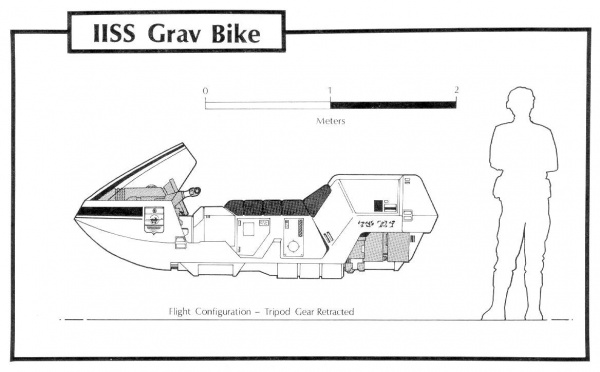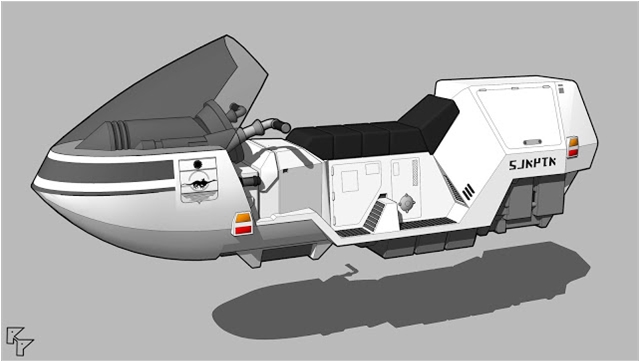IISS Grav Cycle
| IISS Grav Cycle | |
|---|---|
| Tech Level | TL–12 |
| Mass | 400.0 liters |
| Cost | Cr48,000 |
| Mode | Flight (Grav) |
| Type | Grav Bike |
| Speed | 300.0 kph |
| Cargo | 50.0 liters |
| Crew | 1 |
| Passengers | 1 |
| Armament | None |
A Grav Bike or Grav Cycle is a personal vehicle meant for the ideal use of a single sophont.
- It is a gravcraft that makes use of Gravitic Control Technology.
Description (Specifications)
The Scout Grav Cycle can carry one driver and one passenger. Its parabolic nose and windshield are designed for both streamlined flight and to protect its riders. Carrying 280 liters of fuel, the craft can mount 800 kg thrust for 78 twenty-four hour days. In eight hour shifts, the fuel supply will last for 234 days.
- Please see Gravcraft or Gravity control technology for more information.
Unloaded, the grav cycle weights 110kg. Fully loaded at 360kg, the cycle has a top speed of 300kph, a cruising speed of 225 kph, and an NOE speed of 190kph. A hatch in the rear opens to a cargo space capable of holding 50 liters of equipment and supplies.
The grav bike has built-in avionics, giving it good nap-of-the-earth capabilities.
Image Repository
- A paramilitary vehicle: an IISS Grav Bike.

- And in 3D:

History & Background (Dossier)
Mercenary units often use these vehicles for artillery forward observers because they tend to be faster than grav belts and can carry additional weapons. Laser carbines and rifles are common for these troops along with a mapbox and good secure communication links to allow them to adjust indirect fire missions.
- Owen's Onslaught The Lunatic Model
References & Contributors (Sources)
| This article is missing content for one or more detailed sections. Additional details are required to complete the article. You can help the Traveller Wiki by expanding it. |
- Classic Traveller DGP Grand Survey
- Grand Census
- Loren Wiseman. Journal of the Travellers' Aid Society 14 (Game Designers Workshop, 1982), .
- Dave Nilsen. Reformation Coalition Equipment Guide (Game Designers Workshop, 1994), .
- Frank Chadwick, Dave Nilsen. Traveller: The New Era (Game Designers Workshop, 1993), 365.
- MegaTraveller World Builder's Handbook
- Author & Contributor: Lord (Marquis) and Master of Sophontology Maksim-Smelchak of the Ministry of Science
